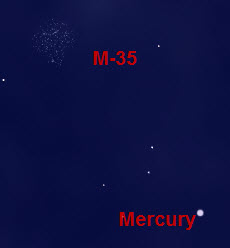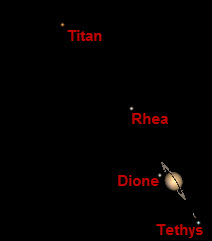| Volume 14 Issue 7 | July 2008 | |
| Planet Watch -- Keeping Track of the Visible Planets | ||
 Mercury is visible over the eastern horizon during the first half of July. On July 12th Mercury will be
passing within about 2 degrees from the open star cluster M-35, near the feet of the Gemini Twins.
Mercury is visible over the eastern horizon during the first half of July. On July 12th Mercury will be
passing within about 2 degrees from the open star cluster M-35, near the feet of the Gemini Twins.
For the rest of the month Mercury will be moving east toward the Sun and superior conjunction on the 29th. Venus is making its evening sky comeback this month as it slowly but steadily becomes more visible over the western horizon at sunset, although it will be rather low above the horizon.  Mars has been steadily moving eastward toward the star Regulus in Leo, and the planet Saturn just
to the east of Regulus. On the evening of July 10th Mars and Saturn will be seperated by less then 1 degree, and the two planets will be visible
at the same time in the field of view of low power wide-field eyepieces. And for several evenings leading up to and after the
10th the two planets will be close enough to be seen together using binculars.
Mars has been steadily moving eastward toward the star Regulus in Leo, and the planet Saturn just
to the east of Regulus. On the evening of July 10th Mars and Saturn will be seperated by less then 1 degree, and the two planets will be visible
at the same time in the field of view of low power wide-field eyepieces. And for several evenings leading up to and after the
10th the two planets will be close enough to be seen together using binculars.
This animated image shows the two planets and the waxing crescent Moon during a 10-day period starting with July 1st. Jupiter is at opposition on the 9th which means that it is directly opposite from the Sun with the Earth in between.  At opposition, as with all outer planets from the Earth, Jupiter rises at sunset and sets at sunrise, and will be
visible all night.
At opposition, as with all outer planets from the Earth, Jupiter rises at sunset and sets at sunrise, and will be
visible all night.
Saturn Saturn slowly is drawing away from Regulus in Leo but not nearly as quickly as Mars. This graphic shows Saturn as viewed through a telescope eyepiece with a 1-degree field of view. The rings, while visible, are not as apparent due to the angle at which we are seeing the planet. By next year the rings will be edge-on to use as we cross the ring plane and eventually will be looking down toward the ring tops. Several of Saturn's moons are also visible at this magnification. |
||
| Click Here For More Planet Information |